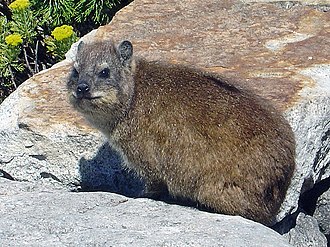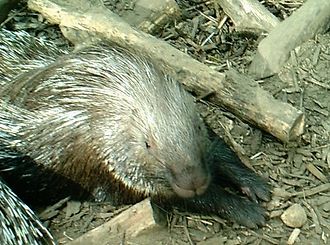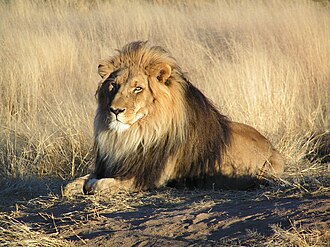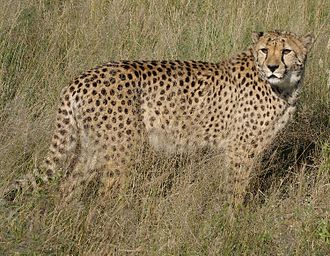List of mammals of Zambia
This is a list of the mammal species recorded in Zambia. There are 237 mammal species in Zambia, of which 1 is critically endangered, 3 are endangered, 8 are vulnerable, and 14 are near-threatened.[1]
The following tags are used to highlight each species' conservation status as assessed by the IUCN:
| EX | Extinct | No reasonable doubt that the last individual has died. |
| EW | Extinct in the wild | Known only to survive in captivity or as a naturalized populations well outside its previous range. |
| CR | Critically Endangered | The species is in imminent risk of extinction in the wild. |
| EN | Endangered | The species is facing an extremely high risk of extinction in the wild. |
| VU | Vulnerable | The species is facing a high risk of extinction in the wild. |
| NT | Near Threatened | The species does not meet any of the criteria that would categorise it as risking extinction but it is likely to do so in the future. |
| LC | Least Concern | There are no current identifiable risks to the species. |
| DD | Data Deficient | There is inadequate information to make an assessment of the risks to this species. |
Some species were assessed using an earlier set of criteria. Species assessed using this system have the following instead of Near Threatened and Least Concern categories:
| LR/cd | Lower Risk/conservation dependent | Species which were the focus of conservation programmes and may have moved into a higher risk category if that programme was discontinued. |
| LR/nt | Lower Risk/near threatened | Species which are close to being classified as Vulnerable but are not the subject of conservation programmes. |
| LR/lc | Lower Risk/least concern | Species for which there are no identifiable risks. |
Subclass: Theria
Infraclass: Eutheria
Order: Macroscelidea (elephant shrews)
Often called sengisi, the elephant shrews or jumping shrews are native to southern Africa. Their common English name derives from their elongated flexible snout and their resemblance to the true shrews.
- Family: Macroscelididae (elephant shrews)
- Genus: Elephantulus
- Short-snouted elephant shrew Elephantulus brachyrhynchus LC
- Dusky elephant shrew Elephantulus fuscus DD
- Genus: Petrodromus
- Four-toed elephant shrew Petrodromus tetradactylus LC
- Genus: Rhynchocyon
- Checkered elephant shrew Rhynchocyon cirnei NT
- Genus: Elephantulus
Order: Tubulidentata (aardvarks)

The order Tubulidentata consists of a single species, the Aardvark. Tubulidentata are characterised by their teeth which lack a pulp cavity and form thin tubes which are continuously worn down and replaced.
- Family: Orycteropodidae
- Genus: Orycteropus
- Aardvark Orycteropus afer LC
- Genus: Orycteropus
Order: Hyracoidea (hyraxes)

The hyraxes are any of four species of fairly small, thickset, herbivorous mammals in the order Hyracoidea. About the size of a domestic cat they are well-furred, with rounded bodies and a stumpy tail. They are native to Africa and the Middle East.
- Family: Procaviidae (hylaxes)
- Genus: Heterohyrax
- Yellow-spotted rock hyrax Heterohyrax brucei LC
- Genus: Procavia
- Cape hyrax Procavia capensis LC
- Genus: Heterohyrax
Order: Proboscidea (elephants)

The elephants comprise three living species and are the largest living land animals.
- Family: Elephantidae (elephants)
- Genus: Loxodonta
- African bush elephant Loxodonta africana VU
- Genus: Loxodonta
Order: Primates


The order Primates contains humans and their closest relatives: lemurs, lorisoids, tarsiers, monkeys, and apes.
- Suborder: Strepsirrhini
- Infraorder: Lemuriformes
- Superfamily: Lorisoidea
- Family: Galagidae
- Genus: Galago
- Mohol bushbaby Galago moholi LR/lc
- Genus: Otolemur
- Brown greater galago Otolemur crassicaudatus LR/lc
- Genus: Galago
- Family: Galagidae
- Superfamily: Lorisoidea
- Infraorder: Lemuriformes
- Suborder: Haplorhini
- Infraorder: Simiiformes
- Parvorder: Catarrhini
- Superfamily: Cercopithecoidea
- Genus: Chlorocebus
- Vervet monkey Cercopithecus pygerythrus LR/lc
- Malbrouck Cercopithecus cynosuros LR/lc
- Family: Cercopithecidae (Old World monkeys)
- Genus: Cercopithecus
- Red-tailed monkey Cercopithecus ascanius LR/lc
- Blue monkey Cercopithecus mitis LR/lc
- Genus: Papio
- Yellow baboon Papio cynocephalus LR/lc
- Chacma baboon Papio ursinus LR/lc
- Subfamily: Colobinae
- Genus: Colobus
- Angola colobus Colobus angolensis LR/lc
- Genus: Colobus
- Genus: Cercopithecus
- Genus: Chlorocebus
- Superfamily: Cercopithecoidea
- Parvorder: Catarrhini
- Infraorder: Simiiformes
Order: Rodentia (rodents)



Rodents make up the largest order of mammals, with over 40 percent of mammalian species. They have two incisors in the upper and lower jaw which grow continually and must be keep short by gnawing. Most rodents are small though the capybara can weigh up to 45 kg (100 lb).
- Suborder: Hystricognathi
- Family: Bathyergidae
- Genus: Cryptomys
- Ansell's mole-rat Cryptomys anselli NT
- Bocage's mole-rat Cryptomys bocagei DD
- Damaraland mole-rat Cryptomys damarensis LC
- Common mole-rat Cryptomys hottentotus LC
- Kafue mole-rat Cryptomys kafuensis VU
- Mechow's mole-rat Cryptomys mechowi LC
- Genus: Cryptomys
- Family: Hystricidae (Old World porcupines)
- Genus: Hystrix
- Cape porcupine Hystrix africaeaustralis LC
- Genus: Hystrix
- Family: Thryonomyidae (cane rats)
- Genus: Thryonomys
- Lesser cane rat Thryonomys gregorianus LC
- Greater cane rat Thryonomys swinderianus LC
- Genus: Thryonomys
- Family: Bathyergidae
- Suborder: Sciurognathi
- Family: Anomaluridae
- Subfamily: Anomalurinae
- Genus: Anomalurus
- Lord Derby's scaly-tailed squirrel Anomalurus derbianus LC
- Genus: Anomalurops
- Beecroft's scaly-tailed squirrel Anomalurops beecrofti LC
- Genus: Anomalurus
- Subfamily: Anomalurinae
- Family: Pedetidae (spring hare)
- Genus: Pedetes
- Springhare Pedetes capensis LC
- Genus: Pedetes
- Family: Sciuridae (squirrels)
- Subfamily: Xerinae
- Tribe: Protoxerini
- Genus: Heliosciurus
- Gambian sun squirrel Heliosciurus gambianus LC
- Mutable sun squirrel Heliosciurus mutabilis LC
- Genus: Paraxerus
- Boehm's bush squirrel Paraxerus boehmi LC
- Smith's bush squirrel Paraxerus cepapi LC
- Black and red bush squirrel Paraxerus lucifer DD
- Genus: Heliosciurus
- Tribe: Protoxerini
- Subfamily: Xerinae
- Family: Gliridae (dormice)
- Subfamily: Graphiurinae
- Genus: Graphiurus
- Johnston's African dormouse Graphiurus johnstoni DD
- Small-eared dormouse Graphiurus microtis LC
- Monard's dormouse Graphiurus monardi DD
- Rock dormouse Graphiurus platyops LC
- Genus: Graphiurus
- Subfamily: Graphiurinae
- Family: Nesomyidae
- Subfamily: Dendromurinae
- Genus: Dendromus
- Gray climbing mouse Dendromus melanotis LC
- Brant's climbing mouse Dendromus mesomelas LC
- Chestnut climbing mouse Dendromus mystacalis LC
- Nyika climbing mouse Dendromus nyikae LC
- Genus: Steatomys
- Kreb's fat mouse Steatomys krebsii LC
- Tiny fat mouse Steatomys parvus LC
- Fat mouse Steatomys pratensis LC
- Genus: Dendromus
- Subfamily: Cricetomyinae
- Genus: Beamys
- Greater hamster-rat Beamys major NT
- Genus: Cricetomys
- Gambian pouched rat Cricetomys gambianus LC
- Genus: Saccostomus
- South African pouched mouse Saccostomus campestris LC
- Genus: Beamys
- Subfamily: Dendromurinae
- Family: Muridae (mice, rats, voles, gerbils, hamsters, etc.)
- Subfamily: Deomyinae
- Genus: Acomys
- Spiny mouse Acomys spinosissimus LC
- Genus: Lophuromys
- Yellow-spotted brush-furred rat Lophuromys flavopunctatus LC
- Genus: Acomys
- Subfamily: Otomyinae
- Genus: Otomys
- Angoni vlei rat Otomys angoniensis LC
- Dent's vlei rat Otomys denti NT
- Large vlei rat Otomys maximus LC
- Uzungwe vlei rat Otomys uzungwensis EN
- Genus: Otomys
- Subfamily: Gerbillinae
- Genus: Tatera
- Boehm's gerbil Tatera boehmi LC
- Highveld gerbil Tatera brantsii LC
- Bushveld gerbil Tatera leucogaster LC
- Savanna gerbil Tatera valida LC
- Genus: Tatera
- Subfamily: Murinae
- Genus: Aethomys
- Red rock rat Aethomys chrysophilus LC
- Kaiser's rock rat Aethomys kaiseri LC
- Namaqua rock rat Aethomys namaquensis LC
- Nyika rock rat Aethomys nyikae LC
- Genus: Arvicanthis
- African grass rat Arvicanthis niloticus LC
- Genus: Colomys
- African wading rat Colomys goslingi LC
- Genus: Dasymys
- African marsh rat Dasymys incomtus LC
- Angolan marsh rat Dasymys nudipes NT
- Genus: Grammomys
- Woodland thicket rat Grammomys dolichurus LC
- Ruwenzori thicket rat Grammomys ibeanus LC
- Genus: Hybomys
- Peters's striped mouse Hybomys univittatus LC
- Genus: Hylomyscus
- Montane wood mouse Hylomyscus denniae LC
- Genus: Lemniscomys
- Griselda's striped grass mouse Lemniscomys griselda LC
- Single-striped grass mouse Lemniscomys rosalia LC
- Rosevear's striped grass mouse Lemniscomys roseveari DD
- Typical striped grass mouse Lemniscomys striatus LC
- Genus: Malacomys
- Big-eared swamp rat Malacomys longipes LC
- Genus: Mastomys
- Natal multimammate mouse Mastomys natalensis LC
- Genus: Mus
- Desert pygmy mouse Mus indutus LC
- African pygmy mouse Mus minutoides LC
- Neave's mouse Mus neavei DD
- Setzer's pygmy mouse Mus setzeri LC
- Gray-bellied pygmy mouse Mus triton LC
- Genus: Pelomys
- Creek groove-toothed swamp rat Pelomys fallax LC
- Least groove-toothed swamp rat Pelomys minor LC
- Genus: Praomys
- Delectable soft-furred mouse Praomys delectorum NT
- Jackson's soft-furred mouse Praomys jacksoni LC
- Genus: Rhabdomys
- Four-striped grass mouse Rhabdomys pumilio LC
- Genus: Thallomys
- Black-tailed tree rat Thallomys nigricauda LC
- Acacia rat Thallomys paedulcus LC
- Genus: Zelotomys
- Hildegarde's broad-headed mouse Zelotomys hildegardeae LC
- Genus: Aethomys
- Subfamily: Deomyinae
- Family: Anomaluridae
Order: Lagomorpha (lagomorphs)
The lagomorphs comprise two families, Leporidae (hares and rabbits), and Ochotonidae (pikas). Though they can resemble rodents, and were classified as a superfamily in that order until the early twentieth century, they have since been considered a separate order. They differ from rodents in a number of physical characteristics, such as having four incisors in the upper jaw rather than two.
- Family: Leporidae (rabbits, hares)
- Genus: Pronolagus
- Smith's red rock hare Pronolagus rupestris LR/lc
- Genus: Lepus
- Cape hare Lepus capensis LR/lc
- African savanna hare Lepus microtis LR/lc
- Genus: Pronolagus
Order: Soricomorpha (shrews, moles, and solenodons)
The "shrew-forms" are insectivorous mammals. The shrews and solenodons closely resemble mice while the moles are stout-bodied burrowers.
- Family: Soricidae (shrews)
- Subfamily: Crocidurinae
- Genus: Crocidura
- Ansell's shrew Crocidura ansellorum EN
- Reddish-gray musk shrew Crocidura cyanea LC
- Bicolored musk shrew Crocidura fuscomurina LC
- Lesser red musk shrew Crocidura hirta LC
- Moonshine shrew Crocidura luna LC
- Swamp musk shrew Crocidura mariquensis LC
- African black shrew Crocidura nigrofusca LC
- African giant shrew Crocidura olivieri LC
- Small-footed shrew Crocidura parvipes LC
- Pitman's shrew Crocidura pitmani DD
- Lesser gray-brown musk shrew Crocidura silacea LC
- Turbo shrew Crocidura turba LC
- Genus: Suncus
- Greater dwarf shrew Suncus lixus LC
- Lesser dwarf shrew Suncus varilla LC
- Genus: Sylvisorex
- Climbing shrew Sylvisorex megalura LC
- Genus: Crocidura
- Subfamily: Crocidurinae
Order: Chiroptera (bats)
The bats' most distinguishing feature is that their forelimbs are developed as wings, making them the only mammals in the world naturally capable of flight. Bat species account for about 20% of all mammals.
- Family: Pteropodidae (flying foxes, Old World fruit bats)
- Subfamily: Pteropodinae
- Genus: Eidolon
- Straw-coloured fruit bat Eidolon helvum LC
- Genus: Epomophorus
- Peters's epauletted fruit bat Epomophorus crypturus LC
- Wahlberg's epauletted fruit bat Epomophorus wahlbergi LC
- Genus: Epomops
- Dobson's epauletted fruit bat Epomops dobsoni LC
- Franquet's epauletted fruit bat Epomops franqueti LC
- Genus: Lissonycteris
- Angolan rousette Lissonycteris angolensis LC
- Harrison's fruit bat Lissonycteris goliath VU
- Genus: Micropteropus
- Peters's dwarf epauletted fruit bat Micropteropus pusillus LC
- Genus: Plerotes
- D'Anchieta's fruit bat Plerotes anchietae DD
- Genus: Rousettus
- Egyptian fruit bat Rousettus aegyptiacus LC
- Genus: Eidolon
- Subfamily: Pteropodinae
- Family: Vespertilionidae
- Subfamily: Kerivoulinae
- Genus: Kerivoula
- Damara woolly bat Kerivoula argentata LC
- Lesser woolly bat Kerivoula lanosa LC
- Genus: Kerivoula
- Subfamily: Myotinae
- Genus: Myotis
- Rufous mouse-eared bat Myotis bocagii LC
- Cape hairy bat Myotis tricolor LC
- Welwitsch's bat Myotis welwitschii LC
- Genus: Myotis
- Subfamily: Vespertilioninae
- Genus: Eptesicus
- Long-tailed house bat Eptesicus hottentotus LC
- Genus: Glauconycteris
- Butterfly bat Glauconycteris variegata LC
- Genus: Hypsugo
- Anchieta's pipistrelle Hypsugo anchietae LC
- Genus: Laephotis
- Botswanan long-eared bat Laephotis botswanae LC
- Genus: Mimetillus
- Moloney's mimic bat Mimetillus moloneyi LC
- Genus: Neoromicia
- Cape serotine Neoromicia capensis LC
- Melck's house bat Neoromicia melckorum DD
- Banana pipistrelle Neoromicia nanus LC
- Rendall's serotine Neoromicia rendalli LC
- Zulu serotine Neoromicia zuluensis LC
- Genus: Nycticeinops
- Schlieffen's bat Nycticeinops schlieffeni LC
- Genus: Pipistrellus
- Rüppell's pipistrelle Pipistrellus rueppelli LC
- Rusty pipistrelle Pipistrellus rusticus LC
- Genus: Scotoecus
- White-bellied lesser house bat Scotoecus albigula DD
- Hinde's lesser house bat Scotoecus hindei DD
- Dark-winged lesser house bat Scotoecus hirundo DD
- Genus: Scotophilus
- African yellow bat Scotophilus dinganii LC
- White-bellied yellow bat Scotophilus leucogaster LC
- Greenish yellow bat Scotophilus viridis LC
- Genus: Eptesicus
- Subfamily: Miniopterinae
- Genus: Miniopterus
- Lesser long-fingered bat Miniopterus fraterculus LC
- Natal long-fingered bat Miniopterus natalensis NT
- Genus: Miniopterus
- Subfamily: Kerivoulinae
- Family: Molossidae
- Genus: Chaerephon
- Spotted free-tailed bat Chaerephon bivittata LC
- Nigerian free-tailed bat Chaerephon nigeriae LC
- Little free-tailed bat Chaerephon pumila LC
- Shortridge's free-tailed bat Chaerephon shortridgei NT
- Genus: Mops
- Angolan free-tailed bat Mops condylurus LC
- Midas free-tailed bat Mops midas LC
- White-bellied free-tailed bat Mops niveiventer LC
- Genus: Otomops
- Large-eared free-tailed bat Otomops martiensseni NT
- Genus: Tadarida
- Egyptian free-tailed bat Tadarida aegyptiaca LC
- Madagascan large free-tailed bat Tadarida fulminans LC
- African giant free-tailed bat Tadarida ventralis NT
- Genus: Chaerephon
- Family: Emballonuridae
- Genus: Taphozous
- Mauritian tomb bat Taphozous mauritianus LC
- Genus: Taphozous
- Family: Nycteridae
- Genus: Nycteris
- Andersen's slit-faced bat Nycteris aurita DD
- Large slit-faced bat Nycteris grandis LC
- Hairy slit-faced bat Nycteris hispida LC
- Large-eared slit-faced bat Nycteris macrotis LC
- Ja slit-faced bat Nycteris major VU
- Egyptian slit-faced bat Nycteris thebaica LC
- Wood's slit-faced bat Nycteris woodi NT
- Genus: Nycteris
- Family: Megadermatidae
- Genus: Lavia
- Yellow-winged bat Lavia frons LC
- Genus: Lavia
- Family: Rhinolophidae
- Subfamily: Rhinolophinae
- Genus: Rhinolophus
- Blasius's horseshoe bat Rhinolophus blasii NT
- Geoffroy's horseshoe bat Rhinolophus clivosus LC
- Darling's horseshoe bat Rhinolophus darlingi LC
- Rüppell's horseshoe bat Rhinolophus fumigatus LC
- Hildebrandt's horseshoe bat Rhinolophus hildebrandti LC
- Lander's horseshoe bat Rhinolophus landeri LC
- Sakeji horseshoe bat Rhinolophus sakejiensis DD
- Bushveld horseshoe bat Rhinolophus simulator LC
- Swinny's horseshoe bat Rhinolophus swinnyi NT
- Genus: Rhinolophus
- Subfamily: Hipposiderinae
- Genus: Cloeotis
- Percival's trident bat Cloeotis percivali VU
- Genus: Hipposideros
- Sundevall's roundleaf bat Hipposideros caffer LC
- Commerson's roundleaf bat Hipposideros marungensis NT
- Noack's roundleaf bat Hipposideros ruber LC
- Genus: Triaenops
- Persian trident bat Triaenops persicus LC
- Genus: Cloeotis
- Subfamily: Rhinolophinae
Order: Pholidota (pangolins)
The order Philodota comprises the eight species of pangolin. Pangolins are anteaters and have the powerful claws, elongated snout and long tongue seen in the other unrelated anteater species.
- Family: Manidae
- Genus: Manis
- Ground pangolin Manis temminckii LR/nt
- Tree pangolin Manis tricuspis LR/lc
- Genus: Manis
Order: Carnivora (carnivorans)





There are over 260 species of carnivorans, the majority of which feed primarily on meat. They have a characteristic skull shape and dentition.
- Suborder: Feliformia
- Family: Felidae (cats)
- Subfamily: Felinae
- Genus: Acinonyx
- South African cheetah Acinonyx jubatus jubatus VU
- Genus: Caracal
- Caracal Caracal caracal LC
- Genus: Felis
- Southern African wildcat Felis silvestris cafra LC
- Genus: Leptailurus
- Serval Leptailurus serval LC
- Genus: Acinonyx
- Subfamily: Pantherinae
- Genus: Panthera
- Southwest African lion Panthera leo bleyenberghi VU
- Masai lion Panthera leo nubica VU
- African leopard Panthera pardus pardus NT
- Genus: Panthera
- Subfamily: Felinae
- Family: Viverridae (civets, mongooses, etc.)
- Subfamily: Viverrinae
- Genus: Civettictis
- African civet Civettictis civetta LR/lc
- Genus: Genetta
- Angolan genet Genetta angolensis LR/lc
- Common genet Genetta genetta LR/lc
- Rusty-spotted genet Genetta maculata LR/lc
- Genus: Civettictis
- Subfamily: Viverrinae
- Family: Nandiniidae
- Genus: Nandinia
- African palm civet Nandinia binotata LR/lc
- Genus: Nandinia
- Family: Herpestidae (mongooses)
- Genus: Atilax
- Marsh mongoose Atilax paludinosus LR/lc
- Genus: Bdeogale
- Bushy-tailed mongoose Bdeogale crassicauda LR/lc
- Genus: Galerella
- Slender mongoose Galerella sanguinea LR/lc
- Genus: Helogale
- Common dwarf mongoose Helogale parvula LR/lc
- Genus: Herpestes
- Egyptian mongoose Herpestes ichneumon LR/lc
- Genus: Ichneumia
- White-tailed mongoose Ichneumia albicauda LR/lc
- Genus: Mungos
- Banded mongoose Mungos mungo LR/lc
- Genus: Paracynictis
- Selous' mongoose Paracynictis selousi LR/lc
- Genus: Rhynchogale
- Meller's mongoose Rhynchogale melleri LR/lc
- Genus: Atilax
- Family: Hyaenidae (hyaenas)
- Genus: Crocuta
- Spotted hyena Crocuta crocuta LR/cd
- Genus: Proteles
- Aardwolf Proteles cristatus LR/lc
- Genus: Crocuta
- Family: Felidae (cats)
- Suborder: Caniformia
- Family: Canidae (dogs, foxes)
- Genus: Canis
- Side-striped jackal Canis adustus LC
- Genus: Otocyon
- Bat-eared fox Otocyon megalotis LC
- Genus: Lycaon
- Cape wild dog Lycaon pictus pictus EN
- Genus: Canis
- Family: Mustelidae (mustelids)
- Genus: Ictonyx
- Striped polecat Ictonyx striatus LR/lc
- Genus: Poecilogale
- African striped weasel Poecilogale albinucha LR/lc
- Genus: Mellivora
- Ratel Mellivora capensis LR/lc
- Genus: Lutra
- Speckle-throated otter Lutra maculicollis LC
- Genus: Aonyx
- African clawless otter Aonyx capensis LC
- Genus: Ictonyx
- Family: Canidae (dogs, foxes)
Order: Perissodactyla (odd-toed ungulates)

The odd-toed ungulates are browsing and grazing mammals. They are usually large to very large, and have relatively simple stomachs and a large middle toe.
- Family: Equidae (horses etc.)
- Genus: Equus
- Grant's zebra Equus quagga boehmi LC
- Genus: Equus
- Family: Rhinocerotidae
- Genus: Diceros
- South-central black rhinoceros Diceros bicornis minor CR
- Genus: Ceratotherium
- Southern white rhinoceros Ceratotherium simum simum NT
- Genus: Diceros
Order: Artiodactyla (even-toed ungulates)





The even-toed ungulates are ungulates whose weight is borne about equally by the third and fourth toes, rather than mostly or entirely by the third as in perissodactyls. There are about 220 artiodactyl species, including many that are of great economic importance to humans.
- Family: Suidae (pigs)
- Subfamily: Phacochoerinae
- Genus: Phacochoerus
- Common warthog Phacochoerus africanus LR/lc
- Genus: Phacochoerus
- Subfamily: Suinae
- Genus: Potamochoerus
- Bushpig Potamochoerus larvatus LR/lc
- Genus: Potamochoerus
- Subfamily: Phacochoerinae
- Family: Hippopotamidae (hippopotamuses)
- Genus: Hippopotamus
- Hippopotamus Hippopotamus amphibius VU
- Genus: Hippopotamus
- Family: Giraffidae (giraffe, okapi)
- Family: Bovidae (cattle, antelope, sheep, goats)
- Subfamily: Alcelaphinae
- Genus: Alcelaphus
- Lichtenstein's hartebeest Alcelaphus lichtensteinii LR/cd
- Genus: Connochaetes
- Blue wildebeest Connochaetes taurinus LR/cd
- Genus: Damaliscus
- Topi Damaliscus lunatus LR/cd
- Genus: Alcelaphus
- Subfamily: Antilopinae
- Genus: Oreotragus
- Klipspringer Oreotragus oreotragus LR/cd
- Genus: Ourebia
- Oribi Ourebia ourebi LR/cd
- Genus: Raphicerus
- Steenbok Raphicerus campestris LR/lc
- Sharpe's grysbok Raphicerus sharpei LR/cd
- Genus: Oreotragus
- Subfamily: Bovinae
- Genus: Syncerus
- African buffalo Syncerus caffer LR/cd
- Genus: Tragelaphus
- Common eland Tragelaphus oryx LR/cd
- Bushbuck Tragelaphus scriptus LR/lc
- Sitatunga Tragelaphus spekii LR/nt
- Greater kudu Tragelaphus strepsiceros LR/cd
- Genus: Syncerus
- Subfamily: Cephalophinae
- Genus: Cephalophus
- Blue duiker Cephalophus monticola LR/lc
- Red forest duiker Cephalophus natalensis LR/cd
- Yellow-backed duiker Cephalophus silvicultor LR/nt
- Genus: Sylvicapra
- Common duiker Sylvicapra grimmia LR/lc
- Genus: Cephalophus
- Subfamily: Hippotraginae
- Genus: Hippotragus
- Roan antelope Hippotragus equinus LR/cd
- Sable antelope Hippotragus nigerLR/cd
- Genus: Hippotragus
- Subfamily: Aepycerotinae
- Subfamily: Reduncinae
- Subfamily: Alcelaphinae
See also
- List of chordate orders
- List of regional mammals lists
- List of prehistoric mammals
- Mammal classification
- New mammal species
Notes
References
- Lua error in Module:Citation/CS1 at line 4515: attempt to index field 'date_names' (a nil value). [dead link]
- Lua error in Module:Citation/CS1 at line 4515: attempt to index field 'date_names' (a nil value).
- Lua error in Module:Citation/CS1 at line 4515: attempt to index field 'date_names' (a nil value).
- ↑ This list is derived from the IUCN Red List which lists species of mammals and includes mammals that have recently been classified as extinct (since 1500 AD). The taxonomy and naming of the individual species is based on those used in existing Wikipedia articles as of 21 May 2007[update]Template:Dated maintenance category (articles) and supplemented by the common names and taxonomy from the IUCN, Smithsonian Institution, or University of Michigan where no Wikipedia article was available.